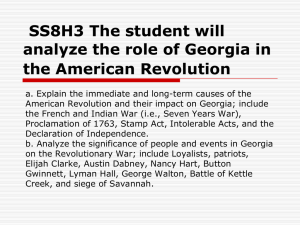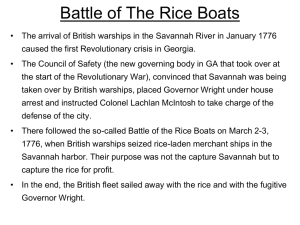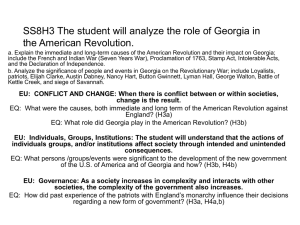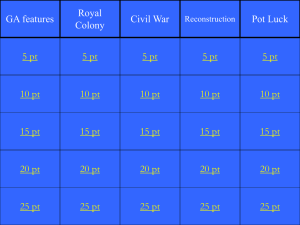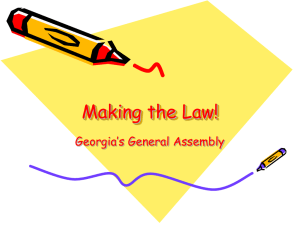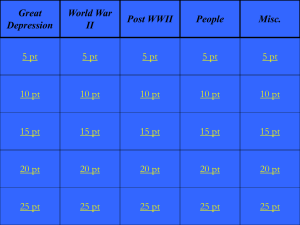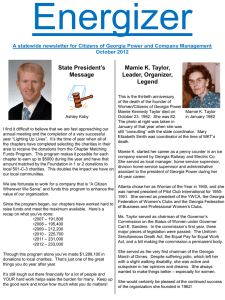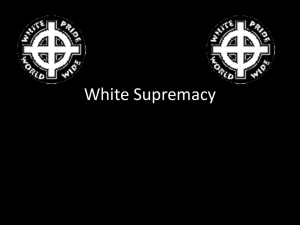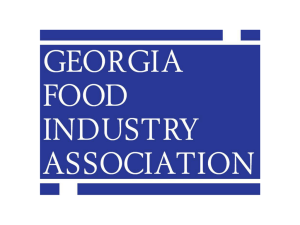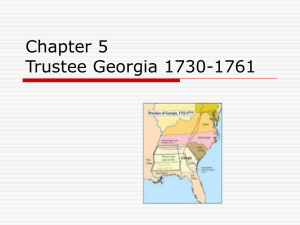Loyalists, patriots, Elijah Clarke, Austin Dabney, Nancy Hart, Button
advertisement
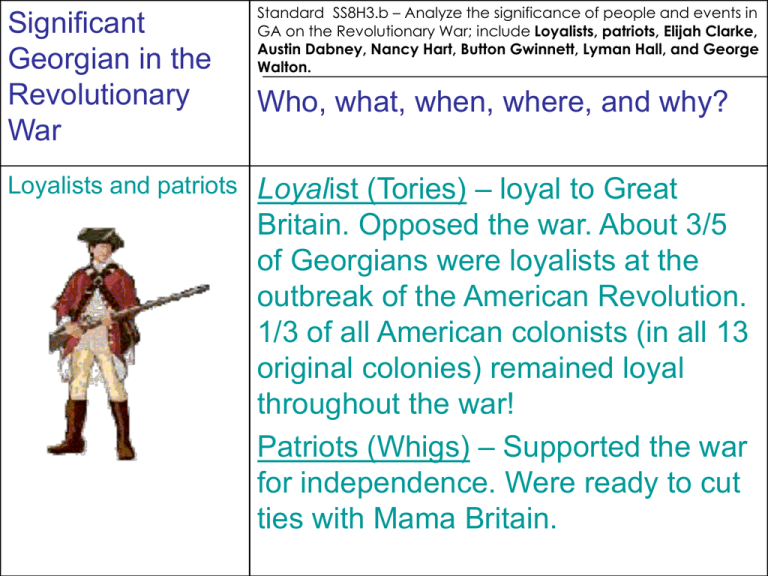
Significant Georgian in the Revolutionary War Loyalists and patriots Standard SS8H3.b – Analyze the significance of people and events in GA on the Revolutionary War; include Loyalists, patriots, Elijah Clarke, Austin Dabney, Nancy Hart, Button Gwinnett, Lyman Hall, and George Walton. Who, what, when, where, and why? Loyalist (Tories) – loyal to Great Britain. Opposed the war. About 3/5 of Georgians were loyalists at the outbreak of the American Revolution. 1/3 of all American colonists (in all 13 original colonies) remained loyal throughout the war! Patriots (Whigs) – Supported the war for independence. Were ready to cut ties with Mama Britain. Significant Georgian in the Revolutionary War Button Gwinnett, Lyman Hall, and George Walton Standard SS8H3.b – Analyze the significance of people and events in GA on the Revolutionary War; include Loyalists, patriots, Elijah Clarke, Austin Dabney, Nancy Hart, Button Gwinnett, Lyman Hall, and George Walton. Who, what, when, where, and why? • These three men signed the Declaration of Independence on Aug. 2, 1776 on behalf of Georgia. • Declaration adopted almost a month earlier on July 4, 1776 though. • Their signatures appear on the left side of the Declaration right under the signature of John Hancock, the president of the 2nd Continental Congress. • Georgians didn’t find out how these men had voted or even what the Declaration said until over a month later. • George Walton, at age 26, was the youngest signer of the Declaration and Button Gwinnett’s autograph is a collector’s dream – valued at more than $250,000. Significant Georgian Who, what, when, where, and why? in the Revolutionary War Col. Elijah Clarke • Military officer from the Georgia militia (fought w/ Col. John Dooley) • He led patriots to victory at The Battle of Kettle Creek in Feb. of 1779. • British strength - more than 800 • GA militia strength – little over 300 • Huge moral booster - GA militia was able to take weapons and horses from the British during and after the battle. •Took over 150 British soldiers as prisoners, over 350 B.S. escape, and 300 B.S. die or flee • Minor when compared to other battles outside Georgia. Significant Georgian in the Revolutionary War Who, what, when, where, and why? Austin Dabney • Enslaved black (mixed) man (born as a free man, then later enslaved) who fought with Elijah Clarke at the B.O.K.C. • Took the place of another man in the state militia. •Credited with saving E. Clarke’s life after Clarke’s horse is shot out from underneath him. Dabney gives Clarke his own horse, despite being wounded himself, so Clarke can continue to lead troops in battle. • After much debate, he was given a 50 acre tract of land after the war in 1786 (and another later in1821) in Madison County, GA; money to buy his freedom; and is given a federal stipend for the remainder of his life. Significant Who, what, when, where, and why? Georgian in the Revolutionary War Nancy Hart According to contemporary accounts, "Aunt Nancy," was a tall, gangly woman who towered six feet in height. Like the frontier she inhabited, she was roughhewn and rawboned, with red hair and a smallpox-scarred face. She was also cross-eyed. One early account pointed out that Hart had "no share of beauty—a fact she herself would have readily acknowledged, had she ever enjoyed an opportunity of looking into a mirror." • Georgia’s most famous war heroine. • Devout patriot known for her determined efforts to rid the area of Tories and English soldiers. • Killed a British loyalists and held 4 others captive at her home when she discovers that they murdered her patriot neighbor Col. John Dooley. • Participated as a patriot spy and messenger during the war. • For most of the war, she was left alone to fend for herself and her children while her husband served as a lieutenant in the GA militia under Elijah Clarke. •Some say she fought at the B.O.K.C.! • Only county to be named for female in GA, Hart County, named for her. Significant Who, what, when, where, and why? Georgian in the Revolutionary War James Wright and Most popular and effective of all Georgia’s Royal the Rice Boat Battle Governors. Made GA economically prosperous and fortified defenses around Savannah. Arrested by Liberty Boys at outbreak of war, imprisoned, but escapes and boards a British warship during the “Battle of the Rice Boats” in Savannah in March 1776. British warships were trying to steal GA rice not take over Savannah. He comes back to govern GA after the Siege of Savannah and leaves again when it is clear that Americans will win the war. Significant Who, what, when, where, and why? Georgian in the Revolutionary War Lachlan McIntosh • Arrived in Georgia from Scotland at eight years of age, part of a group of Scots settlers led by his father, John McIntosh Mohr, who established the town of Darien in 1736. • When his father was captured by the Spanish and imprisoned in 1740, McIntosh lived at Bethesda, the orphanage near Savannah. •Two years later he left Bethesda on orders from General James Oglethorpe to serve as a cadet in the military regiment at Fort Frederica. •After this, he was ran several very successful rice plantations in SC and in Darien, GA, and he became a wealthy man. Significant Who, what, when, where, and why? Georgian in the Revolutionary War Lachlan McIntosh • In January 1775, he helped organize delegates to the Provincial Congress from the Darien District. • McIntosh served during the Revolutionary War (177583), and by January 1776 he had been appointed to the command of the Georgia Battalion with the rank of colonel. •He organized the defense of Savannah and repelled a British assault at the Battle of the Rice Boats in the Savannah River. Promoted to the rank of brigadier general in the Continental army, McIntosh laid plans for the defense of Georgia's southern flank from British incursions from Florida. •He became embroiled in a political dispute with Button Gwinnett, who wanted the command of the Georgia forces and was resentful of McIntosh's success and advancement. Significant Who, what, when, where, and why? Georgian in the Revolutionary War Lachlan McIntosh • He served with General George Washington at Valley Forge, Pennsylvania, in the difficult winter of 1778, then was assigned to the important command of the Western Department. • With Washington's support, McIntosh was entrusted with leading an expedition against Britain's Indian allies in the Ohio Valley. • McIntosh established two forts, Fort Laurens and Fort McIntosh, which helped solidify American control of the Northwest after the Revolution. • McIntosh County, on the Georgia coast, was named in honor of his family. Standards Review – Highlight the following: SS8H2 The student will analyze the colonial period of Georgia's history. Element: SS8H2.a Explain the importance of James Oglethorpe, the Charter of 1732, reasons for settlement (charity, economics, and defense), Tomochichi, Mary Musgrove, and the city of Savannah. Element: SS8H2.b Evaluate the Trustee Period of Georgia's colonial history, emphasizing the role of the Salzburgers, Highland Scots, malcontents, and the Spanish threat from Florida. Element: SS8H2.c Explain the development of Georgia as a royal colony with regard to land ownership, slavery, government, and the impact of the royal governors. SS8H3 The student will analyze the role of Georgia in the American Revolution. Element: SS8H3.a Explain the immediate and long-term causes of the American Revolution and their impact on Georgia; include the French and Indian War (i.e., Seven Years War), Proclamation of 1763, Stamp Act, Intolerable Acts, and the Declaration of Independence. Element: SS8H3.b Analyze the significance of people and events in Georgia on the Revolutionary War; include Loyalists, patriots, Elijah Clarke, Austin Dabney, Nancy Hart, Button Gwinnett, Lyman Hall, George Walton, Battle of Kettle Creek, and siege of Savannah. Turn in Instructions for Warm-ups: 1. Take out all warm-ups for the past 4 weeks. 1. This would be for the following dates: Sept. 14 – Nov. 12 2. Make sure your name and class period are in the upper-right hand corner of your top sheet. 3. I will staple for you when I collect your papers
